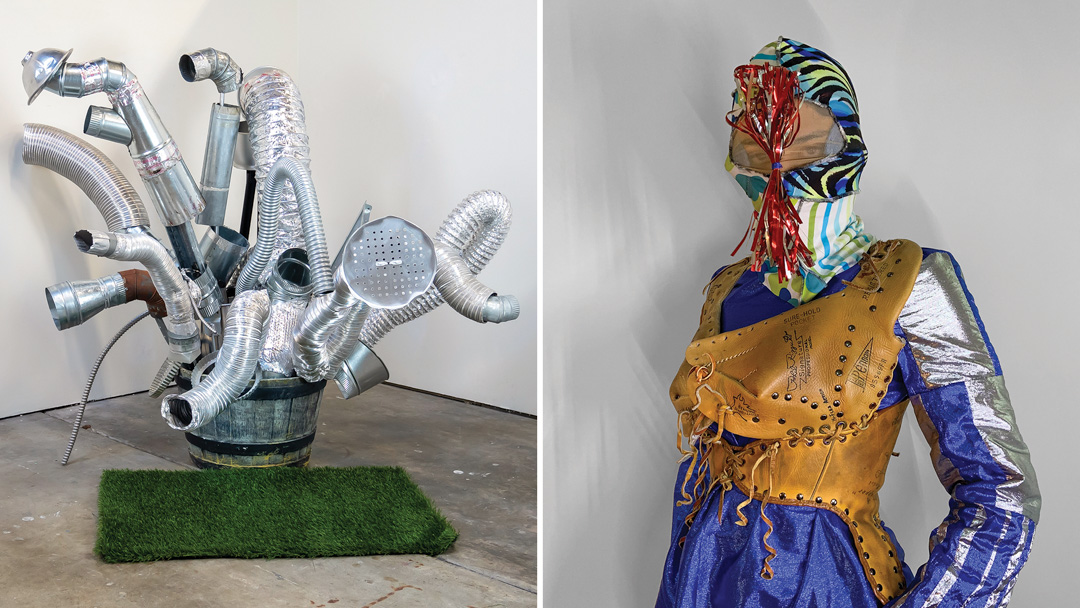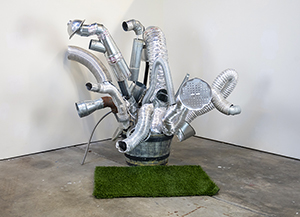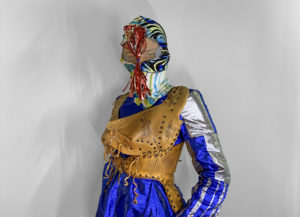
September 10, 2021
FOR IMMEDIATE RELEASE
San Francisco, CA–The Recology Artist in Residence Program (AIR) is pleased to announce an upcoming exhibition for artists Minoosh Zomorodinia and Leilah Talukder.
When:
Reservations are required. https://recologyair-fall2021.eventbrite.com
Friday, October 8 from 4:30-7:30 pm
Saturday, October 9 from 12-2:30 pm
Where:
503 Tunnel Ave/401 Tunnel Ave 94134
In accordance with the City of San Francisco’s Vaccine Requirement, Recology AIR will be requiring proof of full COVID-19 vaccination for all visitors ages 12 years and older and will accept the following forms of verification:
• An original, a copy, or a picture of your CDC vaccination card
• Documentation from a healthcare provider
• Digital COVID-19 vaccine record issued by the State of California
Masks will be required at all times for those over 2 years old.
For the safety of everyone, we are limiting the number of guests allowed in the space at a time. Work will be viewable in 30-minute time slots. Admission is free and open to the public, all ages welcome, wheelchair accessible.
Those unable to attend in person may join the artists on Instagram Live @RecologyAIR on Saturday, October 9 at 11 am. A virtual representation of the exhibition will also be posted on our website after October 22.
 Minoosh Zomorodinia
Minoosh Zomorodinia
The Conduit Between Spaces
Written by Weston Teruya
Minoosh Zomorodinia uses sculpture, video, and the performances of daily life, like walking through the city, to explore how the dynamics of power play out in urban spaces and nature. For her exhibition at Recology, Zomorodinia will exhibit a series of sculptural assemblages and stop motion videos exploring discarded elements from our everyday surroundings, asking us to consider both the weight of our collective consumer excesses and the possibilities for new life in overlooked things.
In one part of Zomorodinia’s exhibition, stacked objects suggest a series of futuristic buildings or monuments overtaken and rebuilt from the trash that remains in a future city. Ductwork, pipes, and conduits are recurring materials in Zomorodinia’s sculptures. In using these objects, she highlights the hidden infrastructure of our everyday surroundings, placing them at the center of new, fantastical architectures. Making them visible strips away building facades to emphasize the labor and resources required to construct and maintain our cities.
While Zomorodinia challenges us to contend with the glut of trash that she faced and reflected upon while in residence, she also infuses the exhibition with an underlying sense of hope. She notes that a major inspiration for the project has been mythological tales that speak to renewal, like the story of Noah’s Ark. Within the installations, she includes stop motion animation videos revealing the assembly of the installations, parts converging and arranging themselves in sculptural forms, granting each object an anthropomorphic sense of play. In doing so, Zomorodinia transmutes these objects from overlooked discards to characters who deserve consideration and new use.
Zomorodinia earned her MFA in New Genres from the San Francisco Art Institute, and holds a Master’s degree in Graphic Design and BA in Photography from Azad University in Tehran. She has received several awards, residences, and grants including the Kala Media Fellowship Award, Headlands Center for the Arts, and California Art Council grants. She has exhibited locally and internationally.
 Leilah Talukder
Leilah Talukder
Patterning Privacy
Written by Weston Teruya
Leilah Talukder utilizes textiles, wearables, and sculpture to explore the role they play in shaping human interactions, desire, and cultural power dynamics. For her exhibition at Recology, Talukder presents a line of wearable pieces that can act as tools in protests for social justice and as resistance against the ever-increasing ubiquity of facial recognition technologies. Fashioned from materials sourced from the Recology Reuse and Recycling Area, Talukder suggests a model for how audiences might create their own jackets, jumpsuits, masks, and vests from what they have available. Rather than opting for the somber, monochromatic designs or high-tech anti-surveillance solutions often used in protest gear, Talukder wields bright colors, contrasting patterns, and repurposed materials in her pieces. Inspired by “dazzle camouflage”—an irregular geometric, black & white pattern that disrupts itself, making the covered object difficult to properly perceive—her work simultaneously embraces tactics of hypervisibility and anonymity. The idea is not to disappear into the background, but to make collective action for justice unmistakable.
Through the series of wearables, Talukder repurposes materials and forms often used by military, riot police, and to signal American cultural power. Dazzle camouflage was first used during World War I to cloak Navy vessels. Forms like bomber jackets and jumpsuits hint at fashion’s fascination with repurposed military wear. In a number of pieces in the line, Talukder deconstructs what she calls “the paraphernalia and accoutrements of American life,” including baseball catcher’s mitts and recycled denim to stitch together new patterns and textures. In breaking apart and redesigning these shapes and symbols, Talukder suggests the ways they might be transmuted to support movements for justice rather than to suppress collective voices.
Leilah Talukder graduated from UC Berkeley with a BA in Art Practice and History of Art with a research focus in Textiles and Garments from a Global Perspective. While there, she was an on-campus organizer with the group FAST (Fashion and Student Trends) where she produced fashion shows and created a course that taught student designers how to sew and conceptualize their work. Talukder’s work was recently featured in an exhibition at Catherine Clark Gallery.
About the Recology Artist in Residence Program
The Artist in Residence Program at Recology San Francisco was established in 1990 to support artists, encourage the conservation of natural resources, and instill a greater appreciation for the environment and art. Artists tackle current social issues, explore personal narratives, discuss the environmental impact of trash, plastic and climate change, and more. Over 200 Bay Area artists have completed residencies.
Contact:
art@recology.com
####